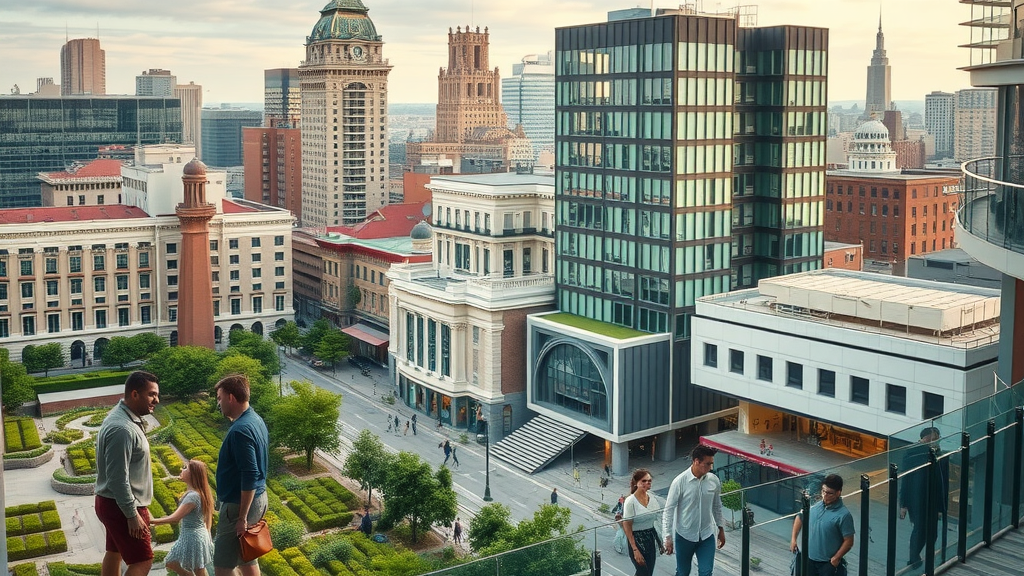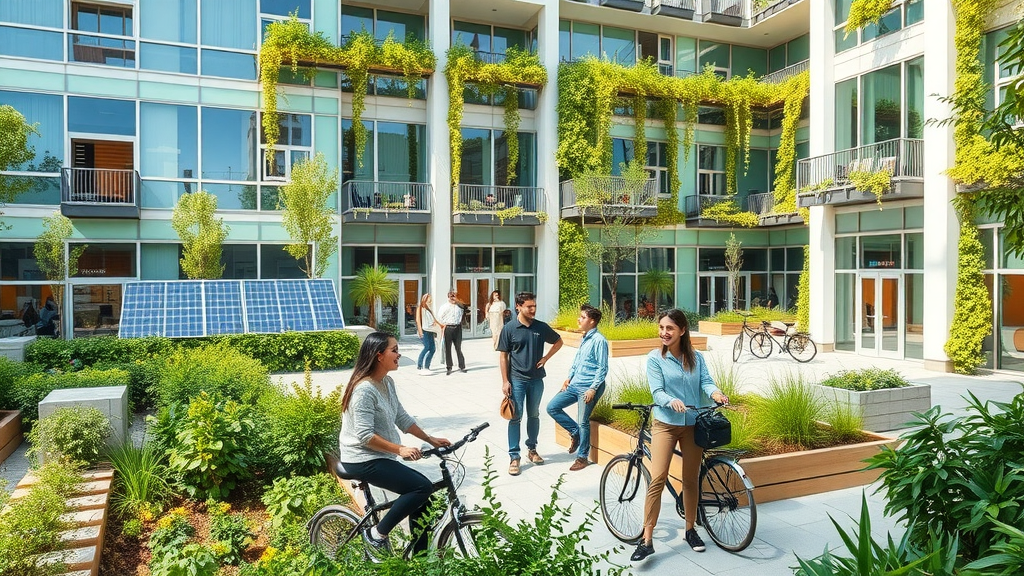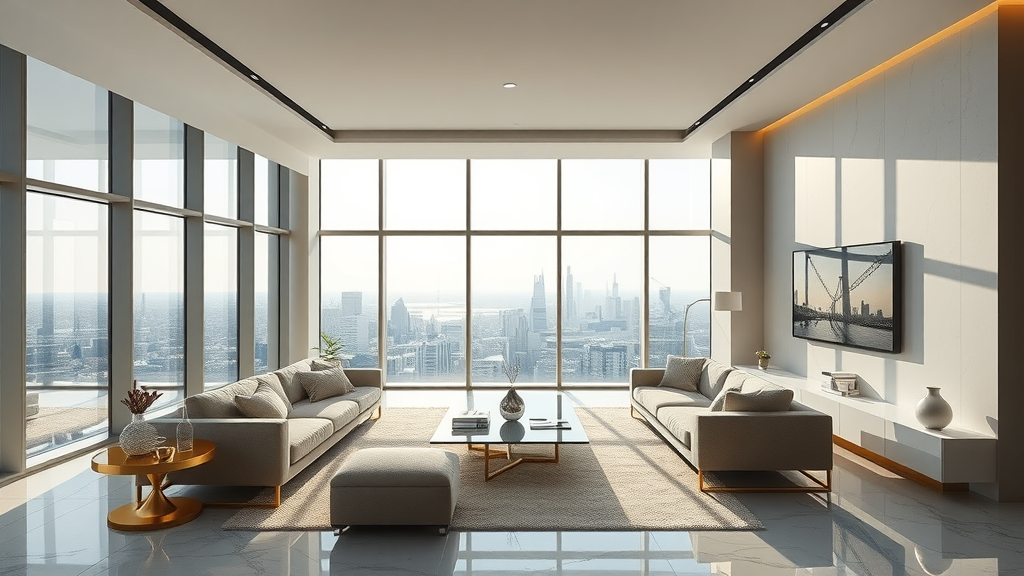Did you know that over 80% of the world’s population now lives in urban spaces shaped by both innovation and tradition? Every building around you began as a concept, yet its construction, architecture, and design create the experiences that define our daily lives. In this article, discover how building construction architecture and design not only creates spaces, but also shapes communities, empowers sustainability, and ignites inspiration for all who inhabit the modern built environment.
A Startling Transformation: The Influence of Building Construction Architecture and Design
“A well-designed building doesn’t just shelter us—it inspires, shapes, and elevates our experiences daily.”
The influence of building construction architecture and design extends far beyond walls and roofs. With each passing decade, the built environment transforms how we work, socialise, and interact with our surroundings. Consider the shift from dark, compartmentalised workspaces of the early 20th century to today’s open-concept, biophilic designs. A good building can become a thriving public space, while poor design can breed alienation or inefficiency.
This transformation is not merely aesthetic; it directly intersects with issues like resource management , community health, and even economic vitality. New buildings and adaptive reuse projects incorporate natural world elements and energy-efficient systems, reflecting a desire to both inspire users and respect the planet. In the coming years, as building design continues to blur the line between art and science, our cities will evolve to become more livable, resilient, and inspiring than ever before.

The Built Environment: Rethinking Urban Space Through Building Construction Architecture and Design
The built environment encompasses all human-made surroundings that offer the setting for human activity, including buildings, parks, and infrastructure. Building construction architecture and design challenges architects, planners, and engineers to rethink conventional approaches. Modern approaches do not simply create places to live or work—they create opportunities for people to connect, innovate, and flourish within their unique environments.
By focusing on adaptive reuse and forward-thinking design, professionals strive to create public spaces that promote well-being and community interaction. A central tenet in the field is integrating the built environment naturally with existing landscapes and cultural narratives. These efforts result in places that are not only functional but also delightful, responding to the needs of the next generation while preserving the identity of the past. As cities continue to grow, the role of urban design becomes ever more crucial in shaping spaces that meet the challenges of density, sustainability, and resilience.
Moreover, the plan of work adopted by architects and construction teams ensures that each step, from conception to completion, addresses the evolving demands of society. Urban projects now increasingly factor in accessibility, transit connectivity, and community engagement. In reimagining the built environment, building construction architecture and design shapes not just infrastructure, but the very soul of modern cities.
What is Building Construction in Architecture?
In its essence, building construction in architecture is the comprehensive process of planning, designing, and erecting physical structures. It involves synthesising artistic vision with technical expertise to deliver safe, functional, and attractive spaces. The process often begins with a conceptual design , after which architects, civil engineers, and contractors collaborate to realise that vision through careful planning, resource allocation, and use of innovative construction techniques .
What sets building construction architecture apart is the constant negotiation between creativity and practicality. While the architectural style defines the visual identity, engineering ensures that buildings can withstand the elements, meet regulations, and cater to evolving needs. Across every era, from ancient Chinese architecture to futurist skyscrapers, this balance has been key to shaping environments where people can thrive. Today’s projects often address public space , sustainability, and community needs, marking a shift towards more accountable and impactful design.
Whether it’s the construction of a new building or the adaptive reuse of historic spaces, architecture remains both a cultural act and a technical pursuit. With growing emphasis on environmental responsibility and user engagement, the world of building construction architecture and design is more vital—and transformative—than ever before.
Designing Buildings for Function and Inspiration
Great architecture is measured not just by its form but by its ability to serve people intuitively. Designing buildings for function and inspiration means weaving together usability, aesthetics, and environmental context. For instance, schools designed with abundant daylight and open social spaces can dramatically enhance student well-being and collaboration, while offices that prioritise quiet zones and flexible layouts amplify productivity and creativity.
The plan of work for designing buildings is rooted in understanding user needs and the broader urban or natural site. Balancing these factors is a continuous process: a marriage of engineering , artistry, and innovation. Architects must think beyond the initial design, considering how their creations will support the occupants’ well-being for years or even centuries to come. As new concepts emerge—such as the integration of smart building technology—the very definition of what makes a ‘good building’ is continually reimagined.
Ultimately, the task of designing buildings blends forward-thinking ambition with practical realities. Each project becomes a testament to the collaborative spirit of designers, engineers, and end users, all striving to shape the future of the built environment for the better.
Key Principles in Designing Building Construction Architecture and Design
- Innovative spatial solutions
- Integration with the natural and urban context
- Prioritising user well-being and efficiency
The key principles guiding successful building construction architecture and design revolve around thoughtful responses to context, technology, and human need. Innovative spatial solutions allow environments to adapt seamlessly to diverse activities—think flexible meeting areas, convertible event spaces, and co-working environments. Integration with the broader urban or natural context ensures that new buildings respect both their physical and cultural landscape, blending tradition with innovation for enduring value.
Prioritising user well-being and efficiency means considering everything from natural light to acoustics, ventilation, and accessibility. Each decision—right down to the materials selected and workflows planned during the plan of work —aims to harmonise performance and comfort. These principles keep the end user at the forefront of each design, promoting environments where creativity and community can flourish. The best architecture is thus not just ‘seen’ but lived and cherished.

Plan of Work: From Concept to Completion in Building Construction Architecture and Design
| Project Stage | Description | Stakeholders |
|---|---|---|
| Conceptual Design | Outlining vision and scope | Architect, Client |
| Detailed Design | Engineering and compliance | Architect, Engineer |
| Construction | Realising the concept | Contractor, Builder |
| Completion | Handover and occupancy | Client, Facility Manager |
The plan of work is a stepwise outline that structures the entire building process. Starting from the initial vision, it ensures that both creative and pragmatic aspects are addressed at every stage—from early concept through construction and handover. This framework not only helps to coordinate architects, engineers, and builders but also streamlines compliance and communication. It’s a dynamic tool that responds to changes in scope, regulatory environments, and evolving user needs, helping to deliver buildings that are truly fit for purpose.
Each phase brings in key professionals to collaborate, aligning client goals with technical realities. This process is essential to achieving high performance , safety, and sustainability. As technologies and methodologies advance, the plan of work continues to adapt, shaping the future of building construction architecture and design for generations to come.
Building Design: Blending Art and Science
At its heart, building design staggers the line between art and science. The aesthetic aspirations of an architect must align with practical considerations of engineering and resource management. While advancements in material science and digital design allow for ever more ambitious forms, these must always be reconciled with safety regulation, budget, and environmental impact.
The true value of building design lies in this balancing act. From the ancient marvels of the century bc to the breathtaking skyscrapers of today, designers grapple with the challenges of gravity, climate, and culture. As buildings are designed, they reflect not only a vision of what’s possible now, but also the aspirations of future generations. Civil engineering and construction management likewise work hand-in-hand during every stage, ensuring visions are grounded in reality and durability.
In the best examples, architecture fuses function, emotion, and inspiration, enriching countless lives and leaving a lasting legacy within the urban and natural world. The partnership between design and engineering is where the future of our cities is written—one project at a time.
How Designing Buildings Impacts the Built Environment
How we approach designing buildings has a profound effect on the built environment . Every decision—from massing to materials, from layout to landscaping—either enhances or undermines a place’s vitality. Projects that respect the principles of durability, inclusiveness, and sustainability become catalysts for positive change, fostering public interaction and civic pride in shared spaces.
Conversely, neglecting context or user safety can jeopardise long-term performance and even erode community bonds. As cities evolve, the ability to learn from past challenges and innovate new concepts is the mark of truly responsible building construction architecture and design . With each new building, there is an opportunity to shape the culture, sustainability, and well-being of those who live and work within its spaces.
Successful design fully acknowledges the changing requirements of the next generation , providing public spaces that flexibly accommodate diverse activities. Ultimately, the ongoing impact of designing buildings radiates outwards, influencing the way urban centres grow, transform, and thrive.

The Role of Civil Engineering in Building Construction Architecture and Design
The close partnership between architecture and civil engineering is fundamental to realising successful building projects. Where architects envision form, experience, and style, civil engineers make those visions safe, stable, and sustainable. Their knowledge ensures structures can withstand forces of nature, comply with rigorous safety regulation, and integrate complex systems like water, energy, and transport seamlessly.
From the initial site investigations and foundation design to resource management and quality assurance on site, civil engineering brings scientific rigour to every stage. As cities densify, opportunities for innovation in construction techniques and materials science become even more critical in delivering high-performance environments. This symbiosis guarantees the integrity, resilience, and long-term value of building construction architecture and design .
Additionally, civil engineering plays a pivotal role in addressing the challenges of climate adaptation and urban resiliency . Their insights directly impact not just the buildings themselves, but the roads, bridges, and infrastructure that underpin vibrant, functional communities.
Sustainable Future: Innovations in Building Construction Architecture and Design
The promise of a sustainable future is now a driving force for the next generation of architects and builders. As the environmental consequences of traditional construction become clearer, the field of building construction architecture and design is pivoting to eco-conscious practices. Today’s innovative projects feature renewable materials, intelligent resource management, and low-impact building practices tailored to each unique setting.
Forward-thinking designs leverage energy-efficient systems and minimise waste, embracing a holistic view that treats every building as part of a dynamic, interconnected ecosystem. This not only reduces carbon footprints but also creates healthier environments for users and surrounding communities. The shift towards high-performance buildings is becoming an industry norm and inspiring a new wave of creativity and accountability among industry professionals.
Ultimately, the sustainable future of buildings depends not just on technology but on a shared commitment across disciplines. Engaged architects, engineers, and clients all have a stake in shaping greener, more responsible, and inspiring places to live and work.
Embracing Environmental Responsibility in the Built Environment
- Renewable materials selection
- Energy-efficient systems
- Low-impact construction practices
The built environment’s journey toward environmental responsibility begins with thoughtful material choices, such as using cross-laminated timber, recycled steel, or local stone. Energy-efficient systems , including passive solar design, advanced insulation, and integrated renewables, further reduce operational carbon emissions. Low-impact construction practices , such as modular assembly and adaptive reuse, help reduce waste and disruption while extending the lifecycle of existing structures.
This trio of strategies is shaping the sustainable future of urban environments. Projects that prioritise eco-friendly approaches not only lead the industry, but also enrich communities, making sustainability a lived reality rather than a distant ideal. As regulations and client demands evolve, these practices will move from optional add-ons to indispensable standards, propelling the building construction architecture and design sector toward a greener tomorrow.

Building Safety and Construction Management in Architecture and Design
At every phase, building safety is paramount. The construction industry grapples with balancing ambitious visions against practical requirements for safety, quality, and cost. From detailed design to completion, architects and managers must integrate stringent safety protocols , ensuring every system, from fire suppression to emergency exits, meets or exceeds safety regulation. The goal is simple: occupants should always trust the environments they inhabit.
Effective construction management provides the backbone for project success. Specialist teams coordinate complex logistics, manage budgets, and resolve unforeseen challenges—all while maintaining rigorous quality standards. The introduction of value engineering techniques further promotes best outcomes by optimising materials and processes for both efficiency and innovation, without compromising on durability or safety.
Ultimately, the true success of any architectural project is reflected not only in its aesthetic brilliance, but also in its enduring performance and protective capacity. The integration of these priorities yields buildings that stand the test of time, fulfilling their purpose for generations.
Prioritising Building Safety during the Plan of Work
From inception to handover, prioritising building safety shapes every phase of the plan of work . Early decisions during conceptual and detailed design—such as material selection, fire safety integration, and structural planning—set the stage for a resilient end product. Contractors and site supervisors uphold these decisions through comprehensive on-site protocols, ongoing risk assessments, and compliance checks.
In parallel, technology such as Building Information Modelling (BIM) and smart monitoring systems now enable real-time oversight, reducing the risk of error and enhancing transparency. Building practices grounded in a culture of safety benefit from continuous education, partnerships, and a willingness to adopt new safety innovations as they emerge, supporting not just short-term success but lasting legacy.
By instilling a commitment to safety at every juncture, the industry affirms its responsibility not just to clients, but to all who interact with the built environment. It is this unyielding dedication that transforms projects from mere structures into safe havens for people and communities.
Balancing Quality, Cost, and Time in Construction Management
- Efficient workflow planning
- Value engineering techniques
- Stringent safety protocols
Effective construction management is a balancing act among quality, cost, and time. Strong project leadership implements efficient workflow planning to maintain momentum and ensure resource allocation remains optimal. Value engineering techniques allow for resourceful substitutions and smarter sequencing, guaranteeing that the highest standards are met without exceeding budgets.
Meanwhile, stringent safety protocols are embedded at every step, ensuring compliance doesn’t waver under tight deadlines. Engaged communication among architects, engineers, and contractors—supported by advanced project management software—creates the conditions for timely, on-budget delivery. The construction industry’s best practices continually evolve in response to innovation, client demand, and shifting regulatory environments, guaranteeing a future where quality never comes second to expediency.
“The success of any project is measured not just in aesthetic appeal, but in longevity, performance, and the safety it provides.”
The Stages and Strategies of Designing Buildings: From RIBA Stage 4A 4B 4C and Beyond
Navigating the delivery of a building project requires a methodical, adaptable approach. The RIBA Plan of Work —including key Stage 4A, 4B, and 4C milestones—serves as the industry-standard framework for guiding projects from concept through completion. These stages encapsulate detailed design (4A), technical design (4B), and pre-construction (4C), ensuring projects remain grounded in real-world requirements as creative ambition takes flight.
At each stage, interdisciplinary collaboration and ongoing stakeholder engagement help address technical, functional, and economic aspirations while keeping sight of the big picture. This ensures emerging challenges are quickly resolved and the project pathway remains aligned with both client vision and regulatory demands.
Focusing meticulously on these stages, architects and managers foster an environment of shared accountability, allowing for innovative, resilient, and people-focused design. RIBA’s plan of work continues to be a touchstone for projects across the globe, providing structure in an ever-changing built environment.
Understanding the Plan of Work in Building Construction Architecture and Design
The plan of work underpins the entire building process, from conception to occupation. Each stage—spanning initial feasibility, creative design, procurement, construction, and building use—has clear deliverables, timelines, and assigned responsibilities. This clarity ensures project momentum and minimises costly delays or misunderstandings.
As projects grow increasingly complex, the value of a robust plan becomes even more critical. Overlapping phases require expert coordination and flexibility, with architects, engineers, and construction managers anticipating change and adapting solutions accordingly. Building construction architecture and design becomes a truly collaborative endeavour, where structure supports creativity rather than stifling it.
The evolution of the plan of work dovetails with technological advancements—such as digital modelling and smart construction tools—allowing teams to visualise, simulate, and refine every detail before breaking ground. The ultimate goal is always the same: realising excellent, liveable, and sustainable spaces.
Careers and Compensation in Building Construction Architecture and Design
The building construction architecture and design sector offers a rich and diverse landscape of career opportunities. From the creative realms of conceptualisation to the hands-on coordination of site activities, each role demands unique blend of technical knowledge, problem-solving, and communication skills. Those who excel not only shape skylines, but also set the benchmarks for good building practices worldwide.
Compensation varies widely, with seniority and project complexity playing a significant role in determining salaries. Project directors and senior architects, for example, command top earnings due to their leadership and technical expertise, while construction managers oversee the practical execution of ambitious visions with both authority and finesse.
This sector encourages continuous learning, professional development, and innovation—qualities essential for addressing the evolving demands of the construction industry and the built environment of tomorrow.
What is the Highest Paying Job in Architecture and Construction?
| Job Title | Typical Salary | Key Responsibilities |
|---|---|---|
| Project Director | £80,000+ | Overseeing large-scale project delivery |
| Senior Architect | £50,000–£75,000 | Managing design and client relationships |
| Construction Manager | £45,000–£70,000 | Supervising site and safety operations |
The highest paying jobs in architecture and construction tend to be those with the greatest responsibility and required expertise. Project directors oversee the delivery of complex, high-value developments, ensuring that every element meets client, technical, and safety expectations. Senior architects and construction managers play pivotal roles in both design and execution, exemplifying the blend of artistry and managerial skill that defines the field’s most rewarding positions.
Each of these roles demands deep understanding of plan of work , construction management, and building safety —qualities that are prized by leading firms across the globe.
Defining Architectural Design in Building Construction Architecture and Design
At its most fundamental, architectural design in construction is the creative process that defines the structure, style, and function of a building. It starts with imagination but is always grounded in real-world constraints—technical, cultural, regulatory, and financial. The process not only gives form to new buildings, but also determines how they will serve, inspire, and outlast the generations who use them.
The built environment thus becomes a canvas, reflecting shared values, history, and aspirations through the lens of building construction architecture and design . Whether working on residential homes, commercial complexes, or civic spaces, designers must always balance vision with feasibility, shaping living spaces that are safe, beautiful, and meaningful.
Excellent architectural design is achieved by closely coordinating with engineers, consultants, and contractors, resulting in environments that foster comfort, community, and creativity.
What is Architectural Design in Construction?
Architectural design in construction refers to the integrated planning and creative problem-solving that establish a building’s character and purpose. This encompasses not only the visual aspects—mass, scale, materiality, and layout—but also functional considerations like flexibility, sustainability, and user accessibility.
Modern design strategies consistently address the needs of diverse users while integrating emerging technologies. Digital design tools and parametric modelling, for instance, enable unprecedented experimentation, while time-honoured techniques ensure that buildings remain grounded and practical. At the crossroads of innovation and heritage, today’s architectural design teams shape iconic structures that define city skylines and neighbourhoods alike.
The value of good architectural design is ultimately measured in the quality of life it delivers—not just for today’s users, but for those who will inhabit these spaces in the decades to come.

Expert Opinions: The Future of the Built Environment through Building Construction Architecture and Design
The future of the built environment is already taking shape in the labs and studios of today’s architects and engineers. Innovations like smart building technology, advanced material science, and modular construction methods are not just trends—they are setting new standards for what’s possible. Experts agree that technology will further blur the traditional boundaries between architecture, engineering, and construction management, unlocking creative responses to climate change, urbanisation, and evolving lifestyles.
Tomorrow’s projects will likely embrace systems that respond in real-time to user needs, shifting from static structures toward living, adaptable environments. The buildings of the next generation will increasingly blend digital connectivity, sustainable infrastructure, and human-centred design in ways previously unimaginable. Those who shape the sector will require deep, multidisciplinary expertise to anticipate and solve problems at the intersection of community, technology, and environment.
The shared goal: to continually enhance the quality, inclusivity, and sustainability of the built environment, ensuring every space tells a compelling story about its era and its people.
Innovations Shaping the Sustainable Future of Building Design
- Smart building technologies
- Modular construction methods
- Advanced material science
Smart building technologies are revolutionising climate control, energy management, and real-time user feedback within our built environments. Meanwhile, modular construction methods dramatically reduce both construction time and waste, promoting flexibility and adaptability for future needs. Advances in material science—such as self-healing concrete and bio-based polymers—promise to extend the life and function of future buildings across the globe.
The integration of these innovations is already beginning to redefine construction practices, planning and design strategies, and the way the public engages with the spaces around them. Sustainable future efforts are inspiring a new generation of architects and engineers, advancing the goal of a built environment that enhances life both now and for centuries to come.
Frequently Asked Questions on Building Construction Architecture and Design
- What are the latest trends in building construction architecture and design?
- The latest trends include eco-conscious materials, smart building technologies, flexible public spaces, and adaptive reuse of historic structures. These innovations address sustainability, enhance user experience, and align with the next generation’s needs for community, safety, and efficiency.
- How can individuals influence the built environment?
- Individuals can shape the built environment through advocacy, participation in planning processes, or choosing sustainable and accessible options in their homes and workplaces. Public engagement ensures that building construction architecture and design remain inclusive, responsive, and innovative.
- What qualifications are needed for a successful career?
- Qualifications typically include a degree in architecture, engineering, construction management, or related fields, plus professional certifications and ongoing education. Success also relies on creativity, communication skills, and adaptability to new technologies and best practices.
Reflections: The Ongoing Impact of Building Construction Architecture and Design on Society

The impact of building construction architecture and design extends into every corner of society. As projects become more inclusive, sustainable, and attuned to human well-being, their ripple effects are felt in stronger communities, vibrant economies, and healthier lives. Architectural innovation doesn’t just change skylines—it elevates the human experience, shape the future, and tells the evolving story of civilisation itself.
Every new building, renovation, or adaptive reuse project today reinforces the truth that buildings are designed not just for now, but as part of a broader, ongoing legacy of connection and transformation.
Visit Us for More Building Construction Architecture and Design Insights
Looking to learn more and stay updated on the latest in building construction architecture and design ? Visit us at buildingconstructiontrade.com for fresh perspectives, expert advice, and in-depth news from across the industry!
Actionable step: Whether you’re planning a project or simply passionate about architecture, keep learning, collaborate widely, and make every design choice count towards a brighter built environment.
To deepen your understanding of how building construction architecture and design transform spaces, consider exploring the following resources:
-
“Building Construction Illustrated” by Francis D.K. Ching : This comprehensive guide offers detailed illustrations and explanations of building construction principles, making it an invaluable resource for both students and professionals. ( amazon.com )
-
“Architectural Detailing: Function, Constructibility, Aesthetics” by Edward Allen and Patrick Rand : This book delves into the art and science of architectural detailing, emphasizing the importance of function, constructibility, and aesthetics in design. ( archeyes.com )
These resources provide in-depth insights into the principles and practices that shape the built environment, enhancing your appreciation of the transformative power of architecture and design.
 Add Row
Add Row  Add
Add 


Write A Comment